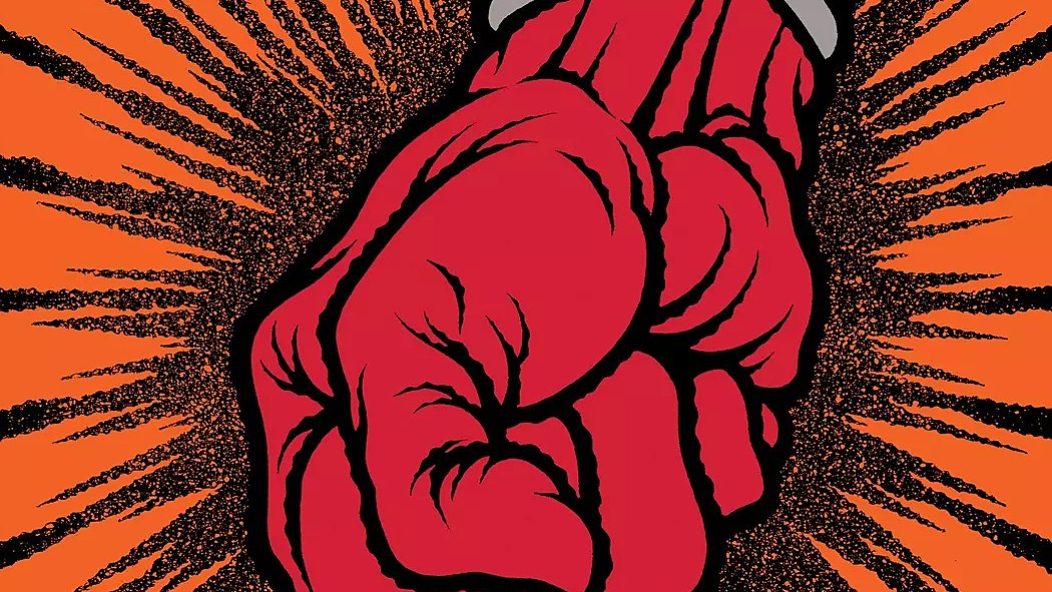
20 Years Ago, Metallica's "St. Anger" Marked the Decline of Mainstream Nu Metal
Part 1: “I drink from the cup of denial”
For the first two years of its existence, I defended St. Anger, Metallica’s eighth studio album. I was 17 when the album came out, just a couple of months away from beginning my senior year of high school. None of my friends liked or even enjoyed the record. I was its sole defender throughout that two-year span.
I remember driving out to Best Buy to buy a copy on the morning of June 5, 2003, the day of its release. At that time, my car’s CD deck was in for repair, which took weeks, so I only had silence when I drove anywhere. I had to wait until I got home—an agonizing 10-minute drive—to hear my favorite metal band’s new offering. And when I’d heard the entire thing, and then watched the bonus DVD of the band playing the entire record later that day, I was hooked. It was thrashy and loud and impudent. After a few listens in the days that followed, I thought it was great, after a few more, superb. After several across that week, I thought it was the best thing they’d ever done.
I was wrong. Entirely wrong. No question about it, no debate needed. I have an excuse, though. I was a nu metal fan in middle and most of high school—I was born in 1986, making me the perfect age for nu-metal’s cultural takeover in the late ’90s and into the 2000s—and my introduction to Metallica was “I Disappear,” so of course I loved St. Anger when it came out. It was frantic and it was angry—in other words, it was my world. (Sorry, couldn’t resist.) The album is definitely angry, but it’s an impotent and immature anger. There are some genuinely good ideas on the album—the clean guitar on “Frantic” and “All Within My Hands”; the riffing and drumming on “Sweet Amber,” especially when they lock together on the bridge—but overall, it’s a poorly executed collection of songs, born from a band in the midst of an identity crisis, both internally and externally, whose lead singer was battling and overcoming addiction.
…
…
And while I’m not going to discuss just how bad and/or crushingly disappointing St. Anger is—that horse has been beaten and killed more times than Deadpool—I will offer a few of my favorite quotes from contemporary reviews doing exactly that. Critics were gleefully vicious towards the album, tripping over each other to write the snarkiest line. Phil Freeman of Houston Press called the album an “ugly mess [that’s] patched together with the ProTools equivalent of staples and Scotch tape.” Michael Christopher of PopMatters labeled James Hetfield’s lyricism on “Frantic” as “simpleton nursery rhyme ramblings.” Joe Gross of The Village Voice suggested Metallica’s attempts at innovation through and inside of nu metal was akin to “New Coke.”
Of course, the most famous contemporary review of them all is Brent DiCrescenzo’s first-person narrative for Pitchfork that references Karl Marx and Jerry Bruckheimer, a piece so absurd that it’s difficult to view it as criticism. He calls the album “an utter mess” and “terrible noise.” He singles out “Invisible Kid” as an example of the band’s “new alloy of ineptitude.” He complains that the “guitars underwent more processing than cat food.” And he ends the piece by arguing Metallica have gone from band to brand, stating that they’d “become less a band leading a genre than a team soaking up payroll in a second-tier sport.”
On that last point, DiCrescenzo isn’t wrong. A band that come out with their own whiskey—a questionable choice, given that Hetfield is a recovering alcoholic—are certainly banking on brand recognition to sell it. But, again, this isn’t about the quality of St. Anger. It’s about the impact (crater) left in its wake with respect to nu-metal. Which is to say: St. Anger was the death knell of nu-metal.
Part 2: “I hide inside, I hurt inside”
Let’s back up a bit. While nu-metal has been despised by the metal community since its birth in the mid-1990s—most of that acrimony was and is justified—it’s nonetheless an important piece of music and cultural history, especially to maladjusted suburban teens. The riffage, the angsty vocals, and “fuck the world” and/or “the world doesn’t understand me” lyricism spoke to millions of kids who were bored with life or frustrated by it or both.
Nu-metal’s takeover was swift, happening just a few years into its existence. 1998 was the genre’s best year in terms of quality albums, including KoЯn’s FOLLOW The LEADEЯ, System of a Down’s self-titled debut, and Rob Zombie’s Hellbilly Deluxe. 1999 was the year its popularity exploded, with KoЯn’s Issues and Limp Bizkit’s Significant Other both debuting at number one on Billboard by selling 573,000 and 640,000 copies, respectively, in their first week of release. (Significant Other returned to number one a month after release, selling another 250,000 copies, thanks to their (in)famous performance at Woodstock ’99.)
Rage Against the Machine’s third album, The Battle of Los Angeles, also debuted at number one upon release, with impressive sales (420,000 copies); it kept Mariah Carey’s then-new album, Rainbow, out of the top spot. And while 2000 was a big year for a handful of albums—most notably, Limp Bizkit’s Chocolate Starfish and the Hotdog Flavored Water going platinum in a week—2001 was probably its commercial peak. Linkin Park’s debut LP, Hybrid Theory, was the best-selling album of the year—despite releasing in 2000 and never reaching number one—and being the best-selling rock album of the century, Staind’s Break the Cycle was the number five seller, and Creed’s Weathered came in at number eight. Turns out, disaffected teens buy a lotta CDs.
By 2003, however, nu metal was already hemorrhaging cultural cachet. Linkin Park’s follow-up,
It’s possible that the genre could’ve survived a bit longer, or perhaps staged a comeback in 2004 or 2005. The 2004 Linkin Park/Jay-Z collaborative EP, Collision Course, was a surprise hit (and a lotta fun), while Slipknot’s Vol. 3: (The Subliminal Verses) from the same year demonstrated that nu-metal acts could branch out and be heavy on the same album. Meanwhile, the post-Pantera supergroup Damageplan showed a lot of promise on their 2004 debut LP, New Found Power. KoЯn and Limp Bizkit both bounced back with promising new music in 2005 (see below), while System of a Down issued two excellent albums that year.
But nu-metal didn’t make a comeback, and instead faded away—and it’s because of St. Anger. To be clear, it’s not simply because St. Anger exists or that it’s an objectively bad (nu-metal) album. Instead, it’s the fact that it’s a bad nu metal album by the biggest heavy metal band ever. St. Anger wasn’t just a mistake—a grave, trend-chasing miscalculation—but a mistake seen by the entire world because it was made by globally-famous musicians. It was akin to a JNCO jeans-diehard teenager seeing their famous actor father in a pair and realizing how ridiculous they look. St. Anger was the most popular metal band on Earth trying on the baggy jeans that all those cool, younger bands were wearing. Indeed, the main riff to St. Anger’s title track is just Sevendust played faster, and “And I want my anger to be healthy / And I want my anger just for me” is just “’Cause you can’t feel my anger, you can’t feel my pain / You can’t feel my torment driving me insane” with a positive spin.
And make no mistake: St. Anger made Metallica look and sound ridiculous. The patience-testing repetitiveness of the songwriting, the wince-inducing production (that ruined it for Kerry King), Hetfield’s lyrics and off-key vocals, the lack of solos—which Kirk Hammett wisely pointed out dated this record to this time—and that goddamn snare drum all combined to make a spellbindingly terrible concoction. Hetfield, Hammett, Lars Ulrich, and Bob Rock drove that car off a cliff they either couldn’t see or refused to acknowledge.
Most nu-metal bands saw the cliff, though. KoЯn covered Cameo’s “Word Up!” in 2004 and then worked with The Matrix on their first post-St. Anger album, 2005’s ,em>See You on the Other Side, experimenting with electronic and industrial sounds and resulting in their best record since FOLLOW The LEADEЯ. Limp Bizkit played around with alt rock and metal on 2003’s shaky Results May Vary before returning to their roots with their 2005 EP, The Unquestionable Truth (Part 1), where they morphed into an alt-metal band with something real to say about mass media and abuse of power. Even DevilDriver, the band that emerged after Coal Chamber broke up, realized nu-metal was on its way out. DevilDriver wanted to be a groove metal band on its self-titled 2003 debut, but guitarist Even Pitts was dead set on using nu-metal as the songwriting basis. His replacement, Mike Spreitzer, corrected that on their next (and still best) album, 2005’s The Fury of Our Maker’s Hand.
Similarly, nu-metal giants like Linkin Park and Disturbed were already moving on from the genre by 2002. The former’s Meteora (as well as their 2002 remix album, Reanimation) saw Linkin Park experiment with electronica and alt-rock; they’d continue down that path without looking back, making better music than on their mega-selling debut. Disturbed, similarly, had already decided by their second album, 2002’s Believe, that they wanted to branch out into alt rock and acoustic balladry, with often-better and more interesting songwriting than 2000’s The Sickness. The follow-up, 2005’s Ten Thousand Fists, confirmed their slow transition into an arena rock band. They would continue to wander away from the genre that helped make them famous—something their vocalist, David Draiman, readily admitted in 2009—without a pause to look back over their shoulder. And then there’s Slipknot. After Vol. 3: (The Subliminal Verses), the nine-headed monster got weirder and more extreme with each album; they haven’t stopped evolving since, and they’re better for it.
So yeah, nu-metal was at best a fashion statement that had run its course and was no longer cool. At worst, it had become nuclear waste, something to be avoided at all cost. Unfortunately, this wasn’t as obvious as it seemed.
Part 3: “The motherfuckers got in my head / Trying to make me someone else instead”
Metallica weren’t the only thrash band who struggled to stay relevant in the ’90s. Three of the Big Four of thrash experimented with nu metal during its heyday, attempting to be like the cool kids, to varying degrees and success. I suspect further experimentation with nu metal would’ve occurred had St. Anger not been such a (PR) disaster. Perhaps, then, we should be thankful that St. Anger exists.
Megadeth were the lone holdout. Megadeth seemed to recognize the toxicity of nu-metal, even before St. Anger proved it once and for all. They had their own unfortunate missteps—looking at you, 1999’s Risk and 2013’s Supercollider—but nothing that was a lost-in-the-desert result like Metallica’s. (It should be noted, though, that while neither Risk nor Supercollider are as big a miscalculation as St. Anger, the latter is, counterintuitively, more compelling. A mistake fully committed to is always going to have a more interesting result, however bad it is, than a mistake that’s half-assed. Metallica went all-in on St. Anger, fully believing that was the right path; Megadeth simply dipped their toes into other sounds for its own sake.) With the exception of the arena rock posturing of Risk, Megadeth—to their credit—stuck with thrash throughout nu-metal’s reign. 2001’s The World Needs A Hero and 2004’s The System Has Failed aren’t classics, but they aren’t fashion statements, either. The former is a mostly fun thrash-adjacent record; the latter is a slightly improved version of the former. Despite their respective flaws, both are worthy efforts—and objectively better than St. Anger—released and needed at a time when thrash was on cultural life-support. Megadeth returned to what they do best with 2007’s United Abominations and, aside from Supercollider, have continued on that path.
Anthrax almost avoided nu-metal. During the John Bush era, they experimented with then-modern metal sounds, including alt-metal and groove metal. They came closest to nu-metal on 1995’s Stomp 442, a dated record with some awkward quasi-rapping and lyrics that resemble a No Fear t-shirt (“You can’t touch me ever / Fear burns at my touch”). 1998’s Volume 8: The Threat Is Real is an improvement, a spotty but entertaining groove-ish metal record with less nu-metal influence. (It’s got forays into hard rock, punk, and country, making it their most experimental record to date, and probably the most experimental record of the Big Four of that era.) They realized the miscalculations and began righting the ship with 2003’s We’ve Come for You All, a more coherent and more groove metal-oriented album, as well as their last with Bush. By the time Joey Belladonna returned to the band, and the band returned to thrash, for 2011’s excellent Worship Music, any semblance of nu-metal had been cut out like the tumor that it was.
Slayer, of course, came the closest of the three to an outright embrace of nu-metal with 1998’s Diabolus in Musica and 2001’s God Hates Us All. That embrace even occasionally bled into their lyrics: “You self-rightous fuck / Give me a reason not to rip your fucking face off” is just Kerry King’s version of the Limp Bizkit lyric, “And if my day keeps going this way, I just might / Break your fucking face tonight.” Mostly, though, they stayed on-message like a politician running for office: “Cast out the demigod / Dethrone the demagogue / Cast out the church of God.” It’s a bit stale and tries too hard to be clever, but it’s not as silly as “Some Kind Of Monster”‘s “Ominous / I’m in us.” Both of those Slayer albums are mildly amusing nu-thrash, and the former is probably the best full-length by any of the Big Four during the nu-metal era (even if it is King’s least favorite Slayer record). Slayer returned to form with 2006’s Christ Illusion, welcoming Dave Lombardo back into the band. They continued making good-to-great thrash records until they called it quits in 2019.
So yeah, it’s almost as if St. Anger saved thrash metal (and metal as a whole) from nu-metal by demonstrating how not to do it and/or showing what happens if you fully commit. St. Anger was a warning label to every other metal band, their version of a neon sign reading “Do Not Iron Clothes On Body.” That’s a helluva gift for Metallica to offer, even if it was unintentional. It wasn’t the only one, though.
Part 4: “Can’t you help me be uncrazy?”
Perhaps the most fascinating aspect of St. Anger, and the surrounding attention, is that the documentary about the album’s protracted gestation, Metallica: Some Kind of Monster, is the best rock documentary ever. (If it’s second-best, it’s just behind History of the Eagles.) Indeed, Metallica: Some Kind of Monster is as good as St. Anger is bad. In 2013, Loudwire named the film as the number-one reason to not be mad about the album for its 10th anniversary, arguing that “Basically, Some Kind of Monster explains why St. Anger is what St. Anger is.”
The documentary is a long and often unflinchingly painful look at a metal band trying to write and record an album while also dealing with addiction and rehab, group therapy (while being filmed!), finding a replacement for bassist Jason Newstead, and considering what Metallica’s place is in the world two decades into its existence and long after thrash was king shit in heavy metal. It deals with alpha male egoism, fear of failure, control issues, the pressures of fame, and the importance of friendship and family. It shows larger-than-life people dealing with—and squirming through, and wincing from—being seen by the public (and, to an extent, each other) as anything but larger-than-life people. It’s a lotta heavy stuff, in other words.
Some of the film is deeply uncomfortable. Of particular note is the scene where Ulrich has a heart-to-heart with Dave Mustaine, where Mustaine tries to explain to Ulrich how everything he’s done “fucking backfires” when compared to Metallica, and that he’s felt awful for 20 years from getting kicked out of Metallica due to his drinking. Both men are in tears at different points as they try to understand and relate to each other. Even when Mustaine wrongly blames Ulrich for people on the street taunting Mustaine by yelling “Metallica” at him, you feel Mustaine’s pain and anger in that scene (as well as a piece that was cut out of the film).
Similarly affecting is the scene where Ulrich, Hammett, and Rock are talking about Hetfield’s absence from the band because of his time in recovery. At this point in the film, Hetfield’s been gone for six months. Hammett relays parts of a conversation he’d had with Hetfield, saying that it sounded like Hetfield associates Rock with the “business side of things” instead of as a friend. Rock is visibly hurt by that statement, appearing to hold back tears in silence. In that same scene, Ulrich declares in frustration that Hetfield’s focus on his family, rather than on Metallica, makes him feel “so disrespected.” Right or wrong, it’s powerful.
But Metallica: Some Kind of Monster is often an unintentional comedy, too—and this is where it shines after multiple viewings. It’s got several moments that seem to channel the awkward and/or cringeworthy comedy of Arrested Development, The Office, and Veep—like Hammett’s forehead slap after Ulrich calls out Hetfield for “being a complete dick.” A similar reaction-type “joke” happens when Ulrich and Hammett are all smiles while expressing their excitement about the progress on the record, and they ask Hetfield how he feels. Then it cuts to Hetfield with an expression that suggests he just saw his dog get hit by a car. The film is a collection of superb moments like that.
Ulrich’s aloofness is the most entertaining aspect of the film, though. Being the band’s most honest and outspoken member, it’s unsurprising that he has some of the documentary’s best moments. Early in the film, there’s a revealing moment where he matter-of-factly explains the band’s dictatorial songwriting process, seemingly without self-awareness: “In the past, what we did was, [we] started with a bunch of ideas existing on tape from everybody. Then me and James would sit down and turn those ideas into songs. And then we would tell the rest of the band what to play and when to play and how to play it. There was never any other ways [sic] of doing it.” At another point, after seeing Newstead’s new band, Echobrain, perform, Ulrich and Rock are hanging out in the venue and shooting the shit. Ulrich points to a member of the production crew and says, “There’s a guy in an Echobrain t-shirt.” Rock deadpans, “Yeah, that’s Steve over there. He works at the studio with us.” Ulrich can only manage a “Really?” in reply. Rock then points out multiple other people that either work or worked at the studio as Ulrich stiffly chuckles.
The film’s most amusing scene occurs because of Ulrich’s father, Torben. About a half hour into the film, Ulrich is out in a field with his father and Phil Towle, the band’s performance enhancement coach, talking about how great it is to have his father’s perspective on his career. He also reluctantly admits that “there’s nothing worse than when I have to go to him and play the new record and know that something on there sucks, and he can see right through that in two and a half seconds flat.” Then the film cuts to Ulrich playing new music for his father in the studio. His father thinks for a moment, then says that if he were the band’s advisor, he would say “Delete that.” Ulrich replies that Metallica’s manager, Cliff Burnstein, said the piece of music in question—a strange and eerie instrumental that feels like it might be the intro to a black metal album—should open the new record. Again, Ulrich’s father thinks for a moment, then says, “I really don’t think so.” It’s the best piece of criticism the band received during the entire St. Anger era.
And while “Delete that” and “I really don’t think so” are both excellent advice for that piece of music, it isn’t so for St. Anger as a whole. The album was a mistake, yes, but it was also a learning experience, both for the band and the rest of the world that was watching. Out of the lowest of low points for the biggest metal band ever came a fascinating documentary about a fascinatingly terrible record. Better yet, that very record helped ensure an unfortunate trend—nu-metal—died off. (Yes, Loathe et al have sorta brought it back and infused it with circa-2010s styles of metal, but it’s a different beast now.) We should be grateful for that. More importantly, we should be grateful that St. Anger exists, and that Metallica saw it through to the end. It’s a piece of history—of Metallica’s, and of heavy metal’s—that’s both essential and engrossing is equal measure because it’s a first-ballot hall of fame fuck-up.
About two-thirds of the way into Metallica: Some Kind of Monster, Bernstein is brought in to hear a handful of finished songs for the first time. Arguing against pacing and the inclusion of slower or quieter tracks, he instead says to the band, “If you want people to be able to say, ‘Jesus Christ, there’s no letting up from these guys’ […] then fuck balance.” And for better or worse—yeah, OK, probably that second one—Metallica played chicken with taste and good decision-making and they didn’t flinch. As such, St. Anger is an infinitely intriguing failure. It’s been an important and captivating point in heavy metal for 20 years, and that’s still gonna be the case in another 20. Hate the record all you want, but admit it: if you made it to the end of this piece, there’s a part of you that wants to go listen to it.










![Bad Omens announce new album CONCRETE JUNGLE [THE OST]](https://www.altpress.com/wp-content/uploads/2024/04/17/BadOmens-CROP_2024_JW_0619_Final_V1.jpg)
